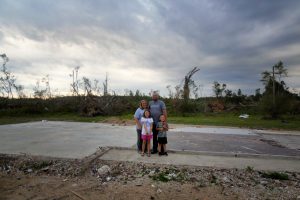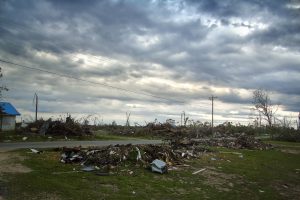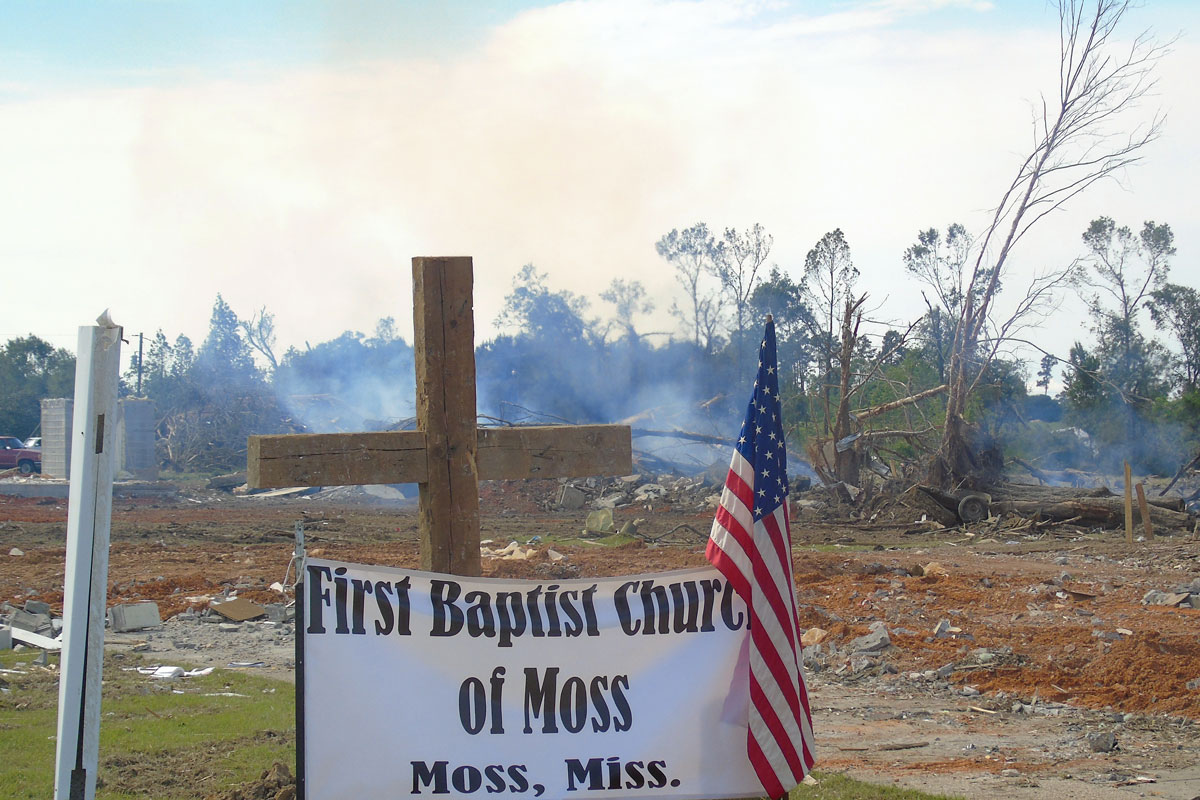MOSSVILLE, Miss.—In five seconds, Charlie Phillips lost the places where decades’ worth of memories were made. His house, his great-grandmother’s old house, the store his grandparents used to own and the post office where his grandmother was postmaster were gone. Mississippi’s largest tornado on record swept them all away on April 12, 2020. It was Easter Sunday.
“I’ve always been a churchgoer, I’ve always had my kids in church,” Phillips said. “But it’s totally different when you put your full trust in God. Sunday afternoon, when that thing came through, I understood full trust. That was the scariest five seconds of my life.”

By Easter evening, Mossville looked apocalyptic. Storms had ravaged much of South Mississippi that day, killing 14 people across the state.
Mossville—sometimes called Moss or, more ironically, “Moss Vegas,” Phillips noted—saw the brunt of Easter’s storms. Jasper County lost at least 20 homes, a church and three businesses, the Jasper County Emergency Management Agency reports.
When Lt. Gov. Delbert Hosemann toured Jasper County on April 16, he described the scene around him as “total obliteration.”
“The state will do its part,” Hosemann told local news station WDAM-7. “We will accelerate everything to help these people.”
‘The Request is Still Under Review’
Yet, over a month later, Jasper County still had not been declared eligible for public disaster relief as of May 19, meaning the county could not remove the mountains of debris lining the sides of its roads.
“It’s sad to see,” said Phillips, who is ready to rebuild. “You come here every day, and it’s just piled up on the road.”
“Maybe (assistance) will come, and they’ll start cleaning up.”
In the weeks since the Easter tornados, his family had burned what they could and, like the rest of Mossville, pushed remains to the curb.
Only Jones, Covington and Jefferson Davis counties were receiving public federal assistance, which helps pay for large debris removal, and that is still true in mid-May as of this story’s publication.
Gov. Tate Reeves secured that initial assistance for those counties by expediting an April 14 request to the Federal Emergency Management Agency for a federal disaster declaration. FEMA approved individual assistance for those three counties on April 16, four days after Easter. FEMA also granted limited public assistance then, and later expanded it to include debris removal, the Mississippi Emergency Management Agency announced on May 9.

FEMA provided no estimate to the Mississippi Free Press of when its review would be finished.
“The request is still under review,” Robert Howard, a media relations manager for the agency, wrote in a May 1 email. “There are many factors that can determine how long the review process will take, so we cannot provide an answer.”
“If any of the requested counties do not receive a declaration, the governor or (MEMA) has the right to appeal and submit further documentation,” he added.
As of Tuesday, May 19, Howard had not answered whether the review had advanced past a regional office, saying only that the review was still underway. Only after FEMA’s federal office finishes its part of the review will it make a decision.
‘They Know That Wasn’t in Jasper County’
The Easter tornadoes destroyed at least 20 homes in Jasper County, as well as six mobile homes, three businesses and a church, the county’s emergency management coordinator, Mike Lucas, confirmed on May 4.
Another 57 homes, 16 mobile homes and a church suffered damage. About half the damages and destruction were in Mossville.
At least 13 people suffering property devastation had no insurance, Lucas said.
While local officials are cautiously optimistic that public emergency relief will move forward for Jasper County eventually, they still wonder why it was not alongside the three counties in Reeves’ expedited request on April 16.
“For some reason Jasper County was left out,” Ricky Ruffin, the attorney for the county board of supervisors, said on May 5. “We first thought that was because a lot of our damage was right along the (Jones County) line. That obviously wasn’t it. They know that wasn’t in Jasper County.”

Reeves’ office referred the Mississippi Free Press to MEMA for comment.
“The original disaster declaration for the April 12 storms, which included Covington, Jefferson Davis and Jones counties was expedited,” MEMA’S public information officer Kelly Richardson wrote in a May 6 email.
“We were acting quickly to get resources to areas that were badly hit, and at that time we only had damage reports and information for those three counties. Now that more damage information has been collected for Jasper County, we have requested that Jasper County be included in the disaster declaration. FEMA has received our request, and they are currently reviewing it.”
A post on MEMA’s website lists 80 “impacted” homes in Jasper County. That post was made on April 16, the same day that President Donald Trump approved Reeves’ expedited request for Jones, Covington and Jefferson Davis counties.
Jasper had the fifth highest number of “impacted” homes in that post, bested only by the three in Reeves’ initial request and Grenada County in North Mississippi, where thousands lost power. The Grenada Star reported on April 13 that, according to MEMA, “more than a dozen” homes were damaged.
Expedited requests allow counties to waive damage assessments, completing them as they go. FEMA declared Jones, Covington and Jefferson Davis counties before those counties’ damage assessments were finished, the agency confirmed.
Jasper County finished joint preliminary damage assessments before MEMA requested that it be added to the April 16 declaration, along with six other counties.
“Based on the severe damage in those three counties, the governor requested an expedited declaration with (preliminary damage assessments) to be completed later,” Howard wrote in a May 1 email. “The other counties completed the PDAs and then a request was made for them to be added.”

‘It’d Break the County’
Debris continues to pile up, but the county cannot afford to pay for removal on its own. “It’d break the county. Our whole budget for the year isn’t as much as clean-up would be,” Jasper County Board of Supervisors attorney Ruffin said.
“We took a gamble and put out an ad for monitors for debris removal, thinking we’d be added on.”
Some 200,000 cubic yards of debris needs to be removed and then burned or chipped, “probably about $2 million,” Ruffin said. Locals are waiting to rebuild or hitch trailers, but the rubble of their own destroyed homes block them.
The county has already cleared roads and set up disposal sites for debris.
“We’re ready to go if we just have someone tell us we’re going to get some federal money,” Ruffin said.
Locals are perplexed—and often furious—that Jasper County was not included in Reeves’ initial request.
While Jones, Covington and Jefferson Davis counties all saw hundreds of homes destroyed or damaged, FEMA looks at other factors when considering requests. Generally, the agency gives public assistance to local governments that are overwhelmed—seemingly one like Jasper County.
“The governor was just trying to speed up the process,” said State Rep. Mark Tullos, who spoke to Reeves’ chief of staff after discovering Jasper County was not in the initial request.
Normally, nothing is done for 30 days following a disaster, Tullos said. Since major damage in Jones, Covington and Jefferson Davis counties was so apparent, those three were rushed through in the expedited request. The other seven counties were tacked on later to save time and skip bureaucracy.

While that response evoked little emotion in counties with only a few damaged roofs, it infuriated Jasper County residents who lost their livelihoods.
Mossville locals, volunteers and emergency response workers agree with the lieutenant governor that their small, unincorporated community underwent “total obliteration.” As state officials poured into the county to see damages for themselves, and as FEMA surveyed the area with drones, county residents who lost everything carried on.
With no explanation of why they were left out of Reeves’ initial request, a popular theory took root on social media the week after Easter. Someone must have been confused, it contended. State officials thought Mossville—barely over the county line—was in Jones County, not Jasper.
Everyone from the county’s emergency management coordinator to Tullos shot down that theory. Mossville wasn’t forgotten, many believe.
“Total obliteration” simply didn’t warrant an expedited request.
___________________________
Timeline: Forgotten Jasper County, 2020
April 12, Easter: Nine tornadoes rip across Mississippi, killing 14 people. Most of the damage is in the southern half of the state, where the widest tornado on record in Mississippi history—and the third widest in American history—touches down. Gov. Tate Reeves declares a state of emergency that night.
April 14: Reeves visits counties across South Mississippi and speaks in Soso. He does not visit Jasper County.
April 14: Reeves and MEMA submit an expedited request for federal assistance to Jones, Jefferson Davis and Covington counties.
April 16: Lt. Gov. Delbert Hosemann visits communities and towns across Jasper County, including Mossville. The devastation he sees is rivaled only by Smithville in 2011, he says. It is “total obliteration of homes and businesses.”
April 16: MEMA publishes initial damage figures on its website. Eighty homes are reported to have been damaged in Jasper County, the fifth highest number of the 24 counties listed.
April 16: President Donald Trump approves an expedited request for individual and public assistance to Jones, Covington and Jefferson Davis. Jasper County is not included, to the shock of locals.
April 19: A popular theory takes root on social media that state officials believed Mossville was in Jones County, not Jasper.
April 20: The Mississippi Emergency Management Agency requests joint preliminary damage assessments for Jasper, Clarke, Carroll, Grenada, Panola, Lawrence and Walthall counties—eight days after the disaster.
April 23-25: The Federal Emergency Management Agency, MEMA and county agencies execute the joint PDAs.
April 27: State Rep. Mark Tullos and Mississippi House Speaker Phillip Gunn meet with Jasper County officials. They visit Mossville that afternoon.
April 27: MEMA requests FEMA to add all seven counties to Reeves’ initial expedited request.
May 1: Disaster assistance centers open in Jones, Covington and Jefferson Davis counties. They help residents of those three counties apply for individual assistance.
May 9: MEMA announces that Jasper and five other counties were approved for individual assistance. Only Carroll County was not approved. In addition, Jones, Covington and Jefferson Davis counties are approved for expanded public assistance, which helps pay for debris removal. There is still no word on public assistance in Jasper County or the other six that MEMA requested be tacked on.
May 12: Disaster assistance centers open in six counties, including Jasper.
May 19: FEMA confirms that the review for public assistance in Jasper County is still underway.






